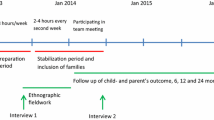Abstract
This mixed-method study examined the facilitators and barriers discussed by 166 informants interviewed from 78 innovative mental health projects. Facilitator and barrier coding reflected two dimensions: the topic of the comment (e.g., funding); and the time phase of the issue’s influence (e.g., pre-decision). Proportions of facilitators to the sum of facilitator and barrier comments made by project informants were calculated. Overall, facilitator proportions were higher for projects that proceeded with implementation than those that did not adopt the practice. In addition, facilitator proportions were generally highest at pre-decision and lowest at full implementation for implementing projects.
Similar content being viewed by others
References
Ajzen, I. (1991). The theory of planned behavior. Organizational Behavior and Human Decision Processes, 50, 179–211.
Barwick, M. A., Boydell, K. M., Stasiulis, E., Ferguson, H. B., Blasé, K., & Fixsen, D. (2005). Knowledge transfer and implementation of evidence-based practices in children’s mental health. Toronto, ON: Children’s Mental Health Ontario.
Blasinsky, M., Goldman, H. H., & Unutzer, J. (2006). Project impact: A report on barriers and facilitators to sustainability. Administration and Policy in Mental Health and Mental Health Services Research, 33, 718–729.
Chiles, J. A., Miller, A. L., Crismon, M. L., Rush, A. J., Krasnoff, A. S., & Shon, S. S. (1999). The Texas medication algorithm project: Development and implementation of the schizophrenia algorithm. Psychiatric Services, 50, 69–74.
Corrigan, P. W., Steiner, L., McCracken, S. G., Blaser, B., & Barr, M. (2001). Strategies for disseminating evidence-based practices to staff who treat people with mental illness. Psychiatric Services, 52, 1598–1606.
Damanpour, F. (1987). The adoption of technological, administrative, and ancillary innovations: Impact of organizational factors. Journal of Management, 13, 675–688.
Damanpour, F. (1991). Organizational innovation: A meta-analysis of effects of determinants and moderators. The Academy of Management Journal, 34, 555–590.
Drake, R. E., Essock, S. M., Shaner, A., Carey, K. B., Minkoff, K., Kola, L., et al. (2001). Implementing dual diagnosis services for clients with severe mental illness. Psychiatric Services, 52, 469–476.
Festinger, L. (1957). A theory of cognitive dissonance. Stanford, CA: Stanford University Press.
Folkes, V. S. (1988). The availability heuristic and perceived risk. Journal of Consumer Research, 15, 13–23.
Frambach, R. T., & Schillewaert, N. (2002). Organizational innovation adoption: A multi-level framework of determinants and opportunities for future research. Journal of Business Research, 55, 163–176.
Glisson, C. (2002). The organizational context of children’s mental health services. Clinical Child and Family Psychology Review, 5, 233–253.
Goffman, E. (1959). Presentation of self in everyday life. Garden City, NY: Doubleday Anchor Books.
Goldman, H. H., Ganju, V., Drake, R. E., Gorman, P., Hogan, M., Hyde, P. S., et al. (2001). Policy implications for implementing evidence-based practices. Psychiatric Services, 52, 1591–1597.
Hambrick, D. C., & Mason, P. A. (1984). Upper echelons: The organization as a reflection of its top managers. Academy of Management Review, 9, 193–206.
Henggeler, S. W., Schoenwald, S. K., Borduin, C. M., Rowland, M. D., & Cunningham, P. B. (1998). Multisystemic treatment of antisocial behavior in children and adolescents. New York: Guilford Press.
Hoffman, L. R., & Maier, N. R. F. (1979). Valence in the adoption of solutions by problem-solving groups: Concept, method and results. In L. R. Hoffman’s (Ed.), The group problem solving process: Studies of a valence model (pp. 17–30). New York: Praeger Publishers.
Klein, K. J., Conn, A. B., & Sorra, J. S. (2001). Implementing computer technology: An organizational analysis. Journal of Applied Psychology, 86, 811–824.
Klein, K. J., Dansereau, F., & Hall, R. J. (1994). Level issues in theory development, data collection, and analysis. Academy of Management Review, 19, 195–229.
Klein, K. J., & Sorra, J. S. (1996). The challenge of innovation implementation. Academy of Management Review, 21, 1055–1080.
Kumar, N., Stern, L. W., & Anderson, J. C. (1993). Conducting interorganizational research using key informants. Academy of Management Journal, 36, 1633–1651.
MacCrimmon, K. R., & Wehrung, D. A. (1986). Taking risks: The management of uncertainty. New York: The Free Press.
Meyer, A. D., & Goes, J. B. (1988). Organizational assimilation of innovations: A multilevel contextual analysis. Academy of Management Journal, 31, 897–923.
Nutt, P. C. (2002). Why decisions fail. San Francisco: Berrett-Koehler.
Panzano, P. C., & Roth, D. (2006). The decision to adopt evidence-based and other innovative mental health practices: Risky business? Psychiatric Services, 57, 1153–1161.
Panzano, P. C., Roth, D., Crane-Ross, D., Massatti, R., Carstens, C., Seffrin B. A., & Chaney-Jones, S. (2005). The innovation diffusion and adoption research project (IDARP): Moving the diffusion of research results to promoting the adoption of evidence-based innovations in the Ohio mental health system. In D. Roth, & W. J. Lutz (Vol. 16, Eds.), New Research in mental health. Columbus, OH: Department of Mental Health.
Patton, M. Q. (1990). Qualitative evaluation and research methods. Newbury Park, CA: Sage.
Repenning, N. P. (2002). A simulation-based approach to understanding the dynamics of innovation implementation. Organization Science, 13, 109–127.
Rogers, E. M. (1995). Diffusion of innovations (4th ed.). New York: Free Press.
Rosenheck, R. A. (2001). Organizational process: A missing link between research and practice. Psychiatric Services, 52, 1607–1612.
Rousseau, D. M. (1985). Issues of level in organizational research: multi-level and cross-level perspectives. In L. L. Cummings & B. M. Staw’s (Eds.), Research in organizational behavior (Vol. 7, pp. 1–37). Greenwich, CT: JAI Press.
Rubin, W. V., & Panzano, P. C. (2002). Identifying meaningful subgroups of adults with severe mental disabilities. Psychiatric Services, 53, 452–457.
Seffrin, B. (2007). The views look different from over here. Innovation Diffusion and Adoption Research Project Documents, Bulletin Series. Office of Program Evaluation and Research, Ohio Department of Mental Health. http://www.mh.state.oh.us/oper/research/idarp/idarp.bulletin.3.pdf
Taylor, S. E. (1982). The availability bias in social perception and interaction. In D. Kahneman, P. Slovic & A. Tversky’s (Eds.), Judgment under uncertainty: Heuristics and biases (pp. 190–208). Cambridge, England: Cambridge University Press.
Taylor, S. E., Crocker, J., Fiske, S. T., Sprinzen, M., & Winkler, J. D. (1979). The generalizability of salience effects. Journal of Personality and Social Psychology, 37, 357–368.
Taylor, S. E., & Fiske, S. T. (1978). Salience, attention and attribution: Top of the head phenomena. In L. Berkowitz’s (Ed.), Advances in experimental social psychology (Vol. 11, pp. 249–288). New York: Academic Press.
Thomas, J. B., & McDaniel, R. R., Jr. (1990). Interpreting strategic issues: Effects of strategy and the information-processing structure of top management teams. Academy of Management Journal, 2, 286–306.
Tornatzky, L. G., & Klein, K. J. (1982). Innovation characteristics and innovation adoption implementation: A meta-analysis of findings. IEEE Transactions on Engineering Management, 29, 28–45.
Tversky, A., & Kahneman, D. (1973). Availability: A heuristic for judging frequency and probability. Cognitive Psychology, 5, 207–232.
U.S. Surgeon General. (1999). Mental health: A report of the surgeon general. Washington, DC: U.S. Department of Health and Human Services.
Acknowledgements
This research was funded by grant 1168 from the Ohio Department of Mental Health and by grant 00-65717-HCD from the John D. and Catherine T. MacArthur Foundation Network on Mental Health Policy Research. The authors gratefully acknowledge the key contributions made by Emily Bunt, Rick Massatti and Helen Anne Sweeney and the dedication of other members of the research team who made this investigation possible, including: Dushka Crane-Ross, Carol Carstens, Sheri Chaney-Jones, Pud Baird, Vandana Vaidyanathan and Sheau-yuen Yeo. The authors appreciate three anonymous reviewers whose suggestions inspired a transformed and substantially improved manuscript. We are indebted to the organizational participants in the research who gave generously of their time.
Author information
Authors and Affiliations
Corresponding author
Rights and permissions
About this article
Cite this article
Seffrin, B., Panzano, P.C. & Roth, D. What Gets Noticed: How Barrier and Facilitator Perceptions Relate to the Adoption and Implementation of Innovative Mental Health Practices. Community Ment Health J 44, 475–484 (2008). https://doi.org/10.1007/s10597-008-9151-x
Received:
Accepted:
Published:
Issue Date:
DOI: https://doi.org/10.1007/s10597-008-9151-x




